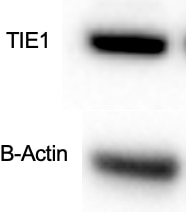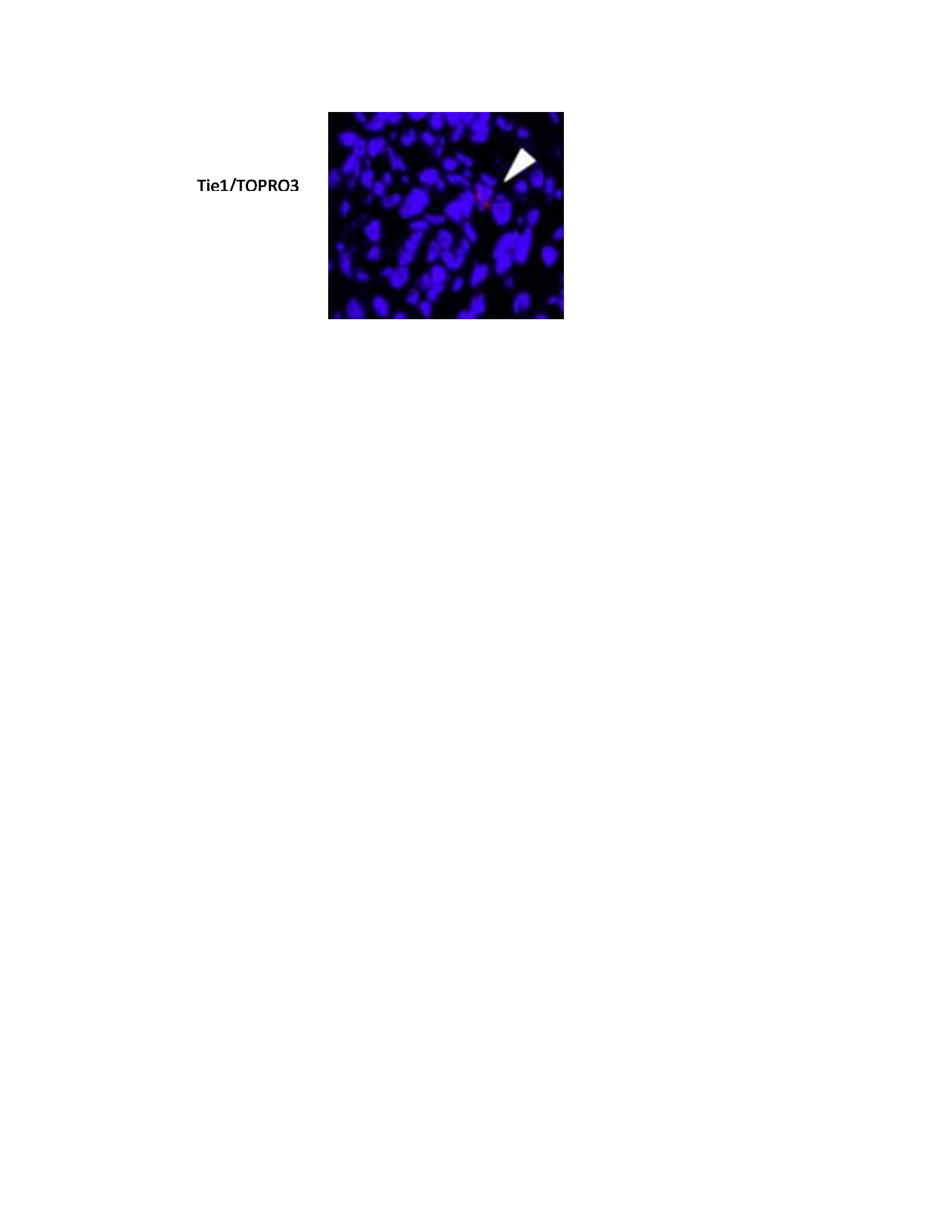Human Tie-1 Antibody Summary
Ala22-Gln760
Accession # P35590
Applications
Please Note: Optimal dilutions should be determined by each laboratory for each application. General Protocols are available in the Technical Information section on our website.
Scientific Data
 View Larger
View Larger
Detection of Tie‑1 in HUVEC Human Cells by Flow Cytometry. HUVEC human umbilical vein endothelial cells were stained with Goat Anti-Human Tie-1 Antigen Affinity-purified Polyclonal Antibody (Catalog # AF619, filled histogram) or control antibody (Catalog # AB-108-C, open histogram), followed by Phycoerythrin-conjugated Anti-Goat IgG Secondary Antibody (Catalog # F0107).
 View Larger
View Larger
Tie‑1 in Human Placenta. Tie-1 was detected in immersion fixed paraffin-embedded sections of human placenta using 8 µg/mL Goat Anti-Human Tie-1 Antigen Affinity-purified Polyclonal Antibody (Catalog # AF619) overnight at 4 °C. Tissue was stained with the Anti-Goat HRP-DAB Cell & Tissue Staining Kit (brown; Catalog # CTS008) and counter-stained with hematoxylin (blue). View our protocol for Chromogenic IHC Staining of Paraffin-embedded Tissue Sections.
Preparation and Storage
- 12 months from date of receipt, -20 to -70 °C as supplied.
- 1 month, 2 to 8 °C under sterile conditions after reconstitution.
- 6 months, -20 to -70 °C under sterile conditions after reconstitution.
Background: Tie-1
Tie-1/Tie (tyrosine kinase with Ig and EGF homology domains 1) and Tie-2/Tek comprise a receptor tyrosine kinase (RTK) subfamily with unique structural characteristics: two immunoglobulin-like domains flanking three epidermal growth factor (EGF)-like domains and followed by three fibronectin type III-like repeats in the extracellular region and a split tyrosine kinase domain in the cytoplasmic region. These receptors are expressed primarily on endothelial and hematopoietic progenitor cells and play critical roles in angiogenesis, vasculogenesis and hematopoiesis.
Human Tie-1 cDNA encodes a 1138 amino acid (aa) residue precursor protein with a 24 residue putative signal peptide, a 735 residue extracellular domain and a 354 residue cytoplasmic domain. Ligands which bind and activate Tie-1 have not been identified. Based on gene-targeting studies, the in vivo functions of Tie-1 have been shown to be related to endothelial cell differentiation and the maintenance of integrity of the endothelium.
- Partanen, J. and D.J. Dumont (1999) Curr. Top. Microbiol. Immunol. 237:159
- Sato, T.N. et al. (1995) Nature 376:70
Product Datasheets
Citations for Human Tie-1 Antibody
R&D Systems personnel manually curate a database that contains references using R&D Systems products. The data collected includes not only links to publications in PubMed, but also provides information about sample types, species, and experimental conditions.
12
Citations: Showing 1 - 10
Filter your results:
Filter by:
-
Polydom/SVEP1 binds to Tie1 and promotes migration of lymphatic endothelial cells
Authors: Ryoko Sato-Nishiuchi, Masamichi Doiguchi, Nanami Morooka, Kiyotoshi Sekiguchi
Journal of Cell Biology
-
Pericyte Loss Leads to Capillary Stalling Through Increased Leukocyte-Endothelial Cell Interaction in the Brain
Authors: YG Choe, JH Yoon, J Joo, B Kim, SP Hong, GY Koh, DS Lee, WY Oh, Y Jeong
Frontiers in Cellular Neuroscience, 2022-03-11;16(0):848764.
Species: Mouse
Sample Types: Protein Lysates
Applications: Western Blot -
Aberrant stromal tissue factor localisation and mycolactone-driven vascular dysfunction, exacerbated by IL-1beta, are linked to fibrin formation in Buruli ulcer lesions
Authors: LT Hsieh, SJ Dos Santos, BS Hall, J Ogbechi, AD Loglo, FJ Salguero, MT Ruf, G Pluschke, RE Simmonds
PloS Pathogens, 2022-01-31;18(1):e1010280.
Species: Human
Sample Types: Cell Lysates
Applications: Western Blot -
Sulfated glycans engage the Ang-Tie pathway to regulate vascular development
Authors: ME Griffin, AW Sorum, GM Miller, WA Goddard, LC Hsieh-Wils
Nat Chem Biol, 2020-10-05;0(0):.
Species: Human
Sample Types: Cell Lysates
Applications: Immunoprecipitation, Western Blot -
Loss of flow responsive Tie1 results in Impaired Aortic valve remodeling
Authors: Xianghu Qu, Kate Violette, M. K. Sewell-Loftin, Jonathan Soslow, LeShana Saint-Jean, Robert B. Hinton et al.
Developmental Biology
-
Structural basis of Tie2 activation and Tie2/Tie1 heterodimerization
Authors: VM Leppänen, P Saharinen, K Alitalo
Proc. Natl. Acad. Sci. U.S.A., 2017-04-10;0(0):.
Species: Human
Sample Types: Cell Lysates
Applications: Western Blot -
Polydom Is an Extracellular Matrix Protein Involved in Lymphatic Vessel Remodeling
Authors: N Morooka, S Futaki, R Sato-Nishi, M Nishino, Y Totani, C Shimono, I Nakano, H Nakajima, N Mochizuki, K Sekiguchi
Circ. Res, 2017-02-08;0(0):.
Species: Mouse
Sample Types: Whole Tissue
Applications: IHC -
Endothelial destabilization by angiopoietin-2 via integrin beta1 activation.
Authors: Hakanpaa L, Sipila T, Leppanen V, Gautam P, Nurmi H, Jacquemet G, Eklund L, Ivaska J, Alitalo K, Saharinen P
Nat Commun, 2015-01-30;6(0):5962.
Species: Human
Sample Types: Whole Cells
Applications: IHC -
Regulated proteolytic processing of Tie1 modulates ligand responsiveness of the receptor-tyrosine kinase Tie2.
Authors: Marron MB, Singh H, Tahir TA, Kavumkal J, Kim HZ, Koh GY, Brindle NP
J. Biol. Chem., 2007-08-29;282(42):30509-17.
Species: Human
Sample Types: Cell Lysates
Applications: Western Blot -
Interaction between Tie receptors modulates angiogenic activity of angiopoietin2 in endothelial progenitor cells.
Authors: Kim KL, Shin IS, Kim JM, Choi JH, Byun J, Jeon ES, Suh W, Kim DK
Cardiovasc. Res., 2006-08-07;72(3):394-402.
Species: Human
Sample Types: Cell Lysates
Applications: Western Blot -
Expansion of human SCID-repopulating cells under hypoxic conditions.
Authors: Danet GH, Pan Y, Luongo JL, Bonnet DA, Simon MC
J. Clin. Invest., 2003-07-01;112(1):126-35.
Species: Human
Sample Types: Whole Cells
Applications: Flow Cytometry -
Evidence for heterotypic interaction between the receptor tyrosine kinases TIE-1 and TIE-2.
Authors: Marron MB, Hughes DP, Edge MD, Forder CL, Brindle NP
J. Biol. Chem., 2000-12-15;275(50):39741-6.
Species: Human
Sample Types: Cell Lysates
Applications: Immunoprecipitation
FAQs
No product specific FAQs exist for this product, however you may
View all Antibody FAQsReviews for Human Tie-1 Antibody
Average Rating: 3.5 (Based on 2 Reviews)
Have you used Human Tie-1 Antibody?
Submit a review and receive an Amazon gift card.
$25/€18/£15/$25CAN/¥75 Yuan/¥2500 Yen for a review with an image
$10/€7/£6/$10 CAD/¥70 Yuan/¥1110 Yen for a review without an image
Filter by:




